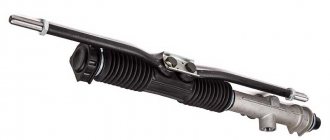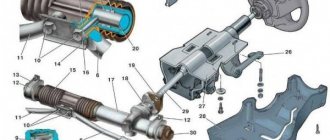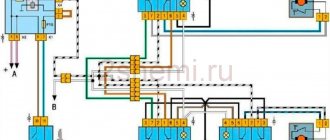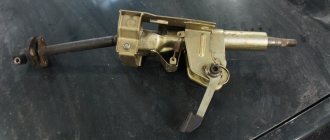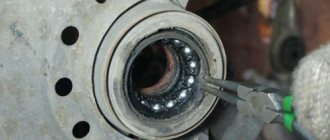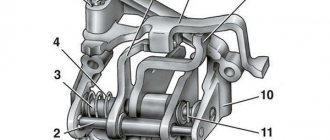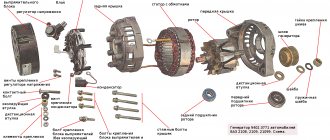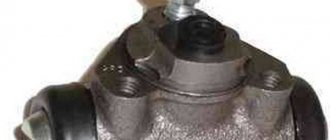The domestic car VAZ 2108 has traveled a long, difficult path with us, becoming a silent witness to numerous life, political, and social collapses and turning points. The G8 appeared back in the eighties, when the country was slowly choosing a new path, still so foggy and alluring.
Of course, like any car, the VAZ sometimes malfunctions. One of the most common car problems is a faulty steering rack. How can driving be without a steering wheel? Let's look at what features the G8 steering has, for what reasons it breaks, and how the VAZ 2108 steering rack is repaired.
Where do the problems start?
Today, like many years ago, the VAZ 2108 is quite popular even though new times have opened the way for numerous interesting import projects. The advantages that keep the model afloat include reliability, durability and low price compared to foreign cars. In such a car, it’s not scary to go to the outback, which is by no means famous for its good roads, and to the country, and it’s not a shame to appear in the city.
Most often in the "eight" the chassis fails
When the car is in good condition, and the traction is good, and the dynamics are not satisfactory, then you enjoy the ride and the speed. But the time of testing comes, and the machine begins to remind you that material things do not last forever. And this is always an unpleasant discovery.
Domestic cars break down more often than foreign cars, the reason lies in both the design technology and the quality of parts. Our people always try to save on everything, even where it is not possible. Speaking about malfunctions of the well-known G8, it is worth remembering such a mechanism as the steering rack, since it is this that breaks down quite often.
At first the problem is not too noticeable, only on difficult sections of the road the steering wheel begins to beat, as if afraid of the problems awaiting the car on the bumpy roads of endless Russia. But soon it begins to pound almost constantly, making the driver feel like an asphalt driller. After such a trip, it’s not easy to get your nerves in order and not shake yourself. In addition, knocking is often heard. These two symptoms signal one thing: the steering rack has failed.
We have two options before us: either go to the nearest auto store and look for a replacement mechanism, or repair the steering rack. The last option is considered the most optimal, economical, but requires a responsible approach.
Causes of rack malfunction
Before we begin repairing the steering rack, let's figure out what actions the car owner takes that lead to its inevitable wear. Firstly, it’s a hectic ride on bumpy roads riddled with potholes and bumps. When faced with such a problematic route, do not drive with full sail, it is better to slow down and then pick up speed. If you give up on the complexity of the road surface, then in the near future there will be absolutely nothing left of the steering rack, like the rest of the equipment.
This is the car part
The second reason lies in defects in the anthers. You should regularly check their condition, since even a small crack can lead to bad consequences: dust, dirt and even moisture will get into the steering rack, which is a disaster for any device. Contamination leads to wear of seals and leaks. As a result, the steering rack needs to be replaced or urgently repaired.
The third reason for problems with the steering wheel is the carelessness of the car owner. Sometimes car owners leave their car in the cold, even with the wheels turned out. The steering rack, like other mechanisms, does not withstand such strength tests.
Change the hydraulic fluid in the power steering mechanism in a timely manner; forgetfulness in this matter leads to irreversible consequences.
Steering repair
Suspension repair in progress
Controlling a VAZ 2108 is a complex thing, but easy to understand, so it is quite possible to repair any faults that have arisen yourself. Most often, parts such as the rod, seals and slide wear out, because the entire operation of the system rests on them. If you hear a telltale knocking and grinding noise in the suspension, it means that the ball joints (rods) have most likely become unusable. You will have to go to a car store or market to buy this part.
Functionality check
From time to time it is necessary to inspect the steering. Where is the best place to start? Be sure to study the condition of the rods, their tightness, and do not forget about the protective cover. Have you noticed cracks or other damage that makes the device leaky? Change it.
You should check whether the steering wheel spoke is in a horizontal plane when the car wheels are in a straight position. If even a slight deviation is observed, it is necessary to identify the cause of the malfunction and eliminate it before it develops into a dangerous problem.
To make sure that the car's steering is working properly, you need to turn the steering wheel all the way clockwise and counterclockwise. In this case, there should be no sounds or jamming. The steering wheel must be firmly and reliably fixed; gaps in the hinges and other parts are unacceptable. Check whether the bolts and nuts of the fastenings are fully tightened.
If something goes wrong when checking the controls, knocking or other problems appear, remove the suspension control rods and check the condition of the steering mechanism again. This will make sure that knocking and malfunctions are caused by malfunctions of the steering wheel, and not by other reasons, of which there may be many.
It is also important to make adjustments. We advise you to use the following rules for proper rack setup.
- When checking the operation of the mechanism, eliminate vertical play in the rods; it should correspond to 15 degrees.
- Steering should be soft and light. Jamming occurs due to improper installation of the steering rack.
- Do not forget to make the next adjustment after 700 kilometers to avoid any serious problems with the steering.
Ball joints are a fragile, fragile part, and they often fail. But there is a very effective way to extend its service life - you sometimes need to pierce the anthers with a syringe and inject one cube of lubricant used for the transmission there. The puncture is small, so there will be no deformation of the part; the hole will immediately be covered with layers of rubber.
Greetings, friends! When I sat behind the wheel of my car for the first time, the first thought that flashed through my head was that this car was assembled from 10, and in winter it will have 4 tracks ((, because I hold the steering wheel in my hands and the car goes to the side , I taxi and lo and behold, she drives herself in the other direction, somehow reaching home, which is no less than 90 km from the place of purchase, straight to the service station, they tightened the rack and the ride became bearable. Repair of the rack/or replacement was postponed indefinitely because naturally the car broke down and it was simply necessary. So I drove away from the beginning of summer until these days... I was thinking about replacing the rack, I wanted to install a new one right away. I consulted with friends: opinions were divided - someone said that repairs were a waste of money, but someone says that even new slats are crap now... Thinking that I would always have time to buy a new slats, I decided to remove and troubleshoot the old slats (having bought a repair kit just in case). I drove the car into the garage and started disassembling it, because my work takes away from me I spent a lot of time taking the rack off slowly. During disassembly there were some surprises. I broke off both rack mounting pins on the side of the left pillar (I wouldn’t wish this on anyone). I decided to deal with the rack first and then rack my brains about the studs. So let’s get started Repair kit
How to change the steering rack on a VAZ 2109?
Sequence of stages:
- Place chocks under the rear wheels, tighten the handbrake, lock the steering wheel, disconnect the power, that is, deactivate the battery terminals.
- Place the car on a jack and remove the wheels, preferably, if such elements are available, put the car on supports. It’s worth warning right away that you may need to replace the steering rack boot on a VAZ 2109.
- Unscrew the nuts from the ends and remove the pins from the strut arms. In this case, you will need a puller - attach it, tighten the screw until it stops and hit the lever with a hammer, holding the puller screw with a wrench. You need to hit it hard enough.
- In the next step, unscrew the clamp nuts. Try using the crank to get to the power plus if you forgot to disconnect the battery. In general, repairing the steering rack with your own hands is quite easy if you strictly follow the recommendations of this material.
- Unscrew the bolt near the floor on the steering shaft inside the cabin.
- Pull the bar towards you in a translational-oscillating motion. Remember that the gear shank will be very difficult to detach from the shaft. As soon as the rail is disconnected, pull out the entire structure through the hole to the right.
- Clamp everything with a vice and clean it with a wire brush, then treat it with cloth and white spirit. Once the aluminum is shining like new, remove the bolts of the mustache. At this stage, it is most important to monitor the condition of the silent blocks. If there is play, cracked rubber or other defects, replace them.
- Bend the plate using a chisel, unscrew the bolts and remove the mustache.
- Pull the plugs from the ends of the rail, and you should also get rid of the rubber of the shaft and the forehead. You can immediately get rid of the cover, but it is recommended to thoroughly rinse and dry the remaining elements, but not in the sun.
- Remove the bearing lock washer by prying it off with a screwdriver. Unscrew the nut with a special wrench, then you will find the bearing.
- Tighten the spline shaft in a vice. It is advisable to put something on their lips. Using a gentle hammer on the housing, wait until the bearing comes out. It should be followed by a shaft, then gears and other parts.
- Wash all the resulting elements thoroughly with white spirit using a brush. Finding this type of bearing is very problematic because it is non-standard, which is why wash it carefully and save it. Use a puller if you still decide to remove it. It is still recommended to leave it, since the conditions for its functioning are very tolerable.
- Shake the rack out of the housing and wash it with white spirit. Dry and lubricate.
- Using gentle movements through the hole in the housing, remove the plastic insert and unscrew the clamping nut. Usually this action can be very difficult, but the repair kit contains a new one, even if you damage this one. Replace the seal rings after shaking out the stop.
- Examine the mustache, the tip should not play, the fingers should move with reasonable effort, and there should be no defects on the covers. If you feel that any of the parts have defects or improper operation, wash the element and dry it, otherwise you can replace it, but try to maintain the length of the lever as much as possible. To protect against corrosion, it is best to treat the threads with Movil at this stage.
- Next, take care of the hinges, install new ones if you don’t like anything about them or seem suspicious.
- Install a new plastic bushing into the housing with the protrusions facing the holes. Cut off the elastic bands.
- Place the rack on the gear side. The approximate distance from the body to the end of the rail should be about twenty-eight millimeters. At the same time, the rail should not protrude outward.
- The bearing together with the gear must be pressed in until it stops; clamp the shaft in a vice together with the housing. In this case, you should not make any special physical efforts.
- Orient the rack along the gear, insert the stop, nut and spring. Plasticine can be used to seal the hole in the nut.
- Install a new rubber ring on the shaft side, then screw on another nut. At the next stage, put on the cover and lock washer, align the marks.
- Place the rubber ring together with the cover and tighten the clamps tightly.
- Set the mustache. They must be tightened with great force; bend the locking plate. Attach the rubber plugs.
- Carefully drag the entire resulting structure into the engine compartment.
- Put the rail in place, put on the clamps, tighten the nuts and under no circumstances forget about the washers.
- It would be nice if the removal of the steering rack on a VAZ 2109 and its further replacement were carried out together with an assistant. The ends of the steering shaft must be aligned on the interior side so that they coincide with the gear shaft. Be sure to pay attention to the special shaft flat into which the coupling bolt should fit.
- Once you've finished baiting, start gently tapping the coupling with a hammer to push it in deeper. The operation of the signal in this case can be regarded as a criterion for the correct installation. If the signal does not buzz, continue to work with a hammer, as soon as the signal starts working, you can assume that the steering rack 2109 is almost ready for further use.
- Insert the bolt on the coupling into the lugs and tighten firmly. Take self-locking nuts and tighten the slats on the clamps, treat the studs with Movil.
If you have experience in replacing the clutch on a VAZ 2109 or in any other repair operations for your car, then replacing the steering rack will not be difficult for you.
Steering rack malfunctions - video. And also replacing the steering tips of the VAZ 2109 with your own hands is a bonus!
Signs of breakdown
By means of steering racks, rotational movements from the steering wheel through a rack and pinion mechanism are transmitted to the rotary levers, which turn the front wheels with rods.
If you find one of the symptoms listed below on your car, be sure to conduct a full diagnosis of the condition of the unit, and then repair it.
Signs of a faulty steering rack include:
- A grinding noise is observed in the rack area when the steering wheel is rotated;
- The steering wheel periodically sticks;
- Lubricant begins to leak from the seals;
- The steering wheel has noticeable play.
These symptoms may also indicate problems in other components of the steering mechanism, but first you must check the condition of the rack, disassemble it and decide whether to replace or repair it.
Node diagram
Removing the steering rack
In order to remove the rail, you must:
- raise the front and remove the wheels;
- unscrew and remove the steering ends;
- disconnect the steering shaft in the cabin;
- Unscrew the steering rack mount and move it to the side;
Disassembly
To disassemble the steering wheel, you will need “special keys” (they are also used for adjustment).
You need to start with the following:
- remove the tie rods (after marking or remembering the side);
- remove the rubber boot and rubber tip;
- unscrew the adjusting and thrust bushings and pull out the shafts;
- remove the plastic sleeve from inside the housing;
- clean the shafts, parts and housing from grease and dirt;
Dismantling
You will not be able to assess the current condition of the steering rack unless you dismantle the device.
There is no optimal way to dismantle the steering rack, since the process in any case involves quite labor-intensive, time-consuming work that involves disassembling many components.
- Suspend the front of the car with a jack to be able to remove the front wheels. Be sure to carefully consider safety measures, install wheel chocks and boots so that the machine does not move while the rack is being repaired.
- Disconnect the gas adsorber, disconnect the wires and take them to the side. This will give you full access to the steering rack.
- Unscrew the bolt from the spline connection. Before doing this, be sure to align the wheels using the steering wheel. The bolt is located near the pedals. To dismantle the fasteners, use a cardan head or a simple spanner.
- Clean the tie rod mounting nuts from accumulated dirt, then undo them using pliers. Unscrew the nuts using a spanner.
- Using a special puller, the rods are disconnected.
- Next, unscrew the rods from the steering rack housing. However, experts recommend dismantling the crankcase with the rods together, since in a vice the removal process is much easier.
- Once you have the rack free, remove it from under the car through the wheel arch. Clean, rinse and clamp in a regular vice.
Now you have a choice - completely replace the steering rack or try to repair it. The second option will take more time, but will save an impressive amount of money.
Preparation for repair
Since we are talking about intervention in the steering system, suspension, special attention should be paid to preparation.
- If you have a lift or inspection pit, you will be able to perform operations much faster and easier, which is the most important thing.
- Be sure to get a set of sockets and spanners. It is extremely difficult to work without them. In addition to the wrenches, you will need wire cutters, pliers, a hammer, a flat head screwdriver, and a tie rod end remover.
- To remove all fasteners that have been tightened for a long time, a can of WD40 will certainly not hurt. It removes oxidation from nuts and removes rust. In addition to the almighty WD40, buy graphite lubricant or grease. By treating the fasteners with them, you will be able to remove them much easier in the future.
- The presence of rags, a metal brush, fresh gasoline or solvent is welcome.
- Ask your friend to help you with your work. It's much easier to change steering wheels with four hands.
Be sure to remove the negative terminal from the battery in order to de-energize the car. We don't want short circuits or burned out wiring.
Repair kit
Hanging the axle
To safely and independently change the steering rack in your own garage, it is extremely necessary to correctly and securely hang the front axle of the car.
Sometimes this issue is not given due attention, as a result of which the car falls, this leads, at best, to damage to the elements of the car, and at worst, to injuries to the repairer himself.
In order to do everything in accordance with safety standards, you need to:
- Place your VAZ 2109 on a level surface. Typically, garage floors are fairly level;
- Install wheel chocks, shoes, bars or other similar means under the rear wheels. Block each wheel front and rear;
- Pull the handbrake all the way to stop the wheels. Just make sure first that the handbrake works;
- Set the steering wheel in neutral position;
- Slightly loosen the fasteners on the wheels;
- The front of the car needs to be raised. Here it is better to use two reliable jacks at once;
- Near the jacks, additionally place metal stops that are adjustable. If there are no special devices, an ordinary block of wood, boards or some kind of stump will do. The main thing is that when you make contact with the body, when you pull or push it, the car does not tip over;
- Remove the front wheels completely and begin replacing the steering racks.
Optimal working conditions
Dismantling
Before installing a new steering rack, you need to get rid of the old one. For this:
- Get to the place where the rack is attached in the engine compartment. To do this, you will probably have to remove the alarm and gas adsorber, at the same time dismantling the hoses.
- Disconnect the rack from the steering column shaft. Before this, the plastic casing is removed, blocking the path to the spline joints. The rack shaft is released by unscrewing one bolt.
- Next, remove the steering ends from the levers. Here haste can significantly harm you. Gradually brush the threaded connections, tip pin and mounting nut with a metal brush. Then apply WD40 to these areas. Give the product a little time to react. Then you can use pliers and a screwdriver to remove the cotter pin from the connection. Once the solvent has taken effect, the nuts should come off without much effort.
- If the tip is in normal condition, it is recommended to remove this element from the strut lever with a puller. A more barbaric method can lead to damage, so you will have to change the tips.
- Unscrew the rack fasteners using keys. It is better to treat them with WD40 in advance.
- After unscrewing the nuts, pry the steering rack with a flat screwdriver and remove it from the studs.
- Call a partner to work together to remove the element through the opening in the wheel arch.
Dismantling and restoration work
Assembling a new unit
Since the rail was removed along with the rods and lugs, the structure should be assembled from new parts before the reassembly process.
- Carefully examine the condition of the boot. If the protective cover shows signs of cracks, defects and other damage, the boot must be replaced;
- To replace the rods or boot, unscrew a pair of mounting bolts, first bending the locking plate with a screwdriver or chisel;
- Next, use pliers to remove the clamps that hold the boot in place;
- Remove the rubber support, spacer ring and dismantle the damaged boot;
- New elements are installed in reverse order.
Preparing for assembly
Installation
Reassembling the unit with a new steering rack looks like this:
- Clean the seat, treat the threaded connection with graphite lubricant or grease.
- With the help of a partner, insert the rail into the engine compartment. By rotating the rack along the axis, you can go around all the obstacles you encounter along the way.
- When you place the mechanism on the studs, put on the clamps and attach the mounting nuts along with new washers.
- Don't let your assistant go too far, because without a second pair of hands you won't be able to handle the next step. One should direct the rack shaft into the cabin, and the second should connect the shaft to the column cross. Make sure that the flat on the shaft aligns with the holes on the coupling. This way you can secure the bolt without any problems. After this, clamp and install the plastic column casing.
- Tighten the nuts securing the steering rack in the engine compartment.
- Connect the tie rod ends to the strut arm and tighten the corresponding mounting nuts.
- Do not forget to treat the threaded connection with graphite lubricant or regular grease.
After replacing the steering rack, be sure to check the result of the repair in motion. To do this, just drive out onto the road and see how the car with the new racks will behave.

